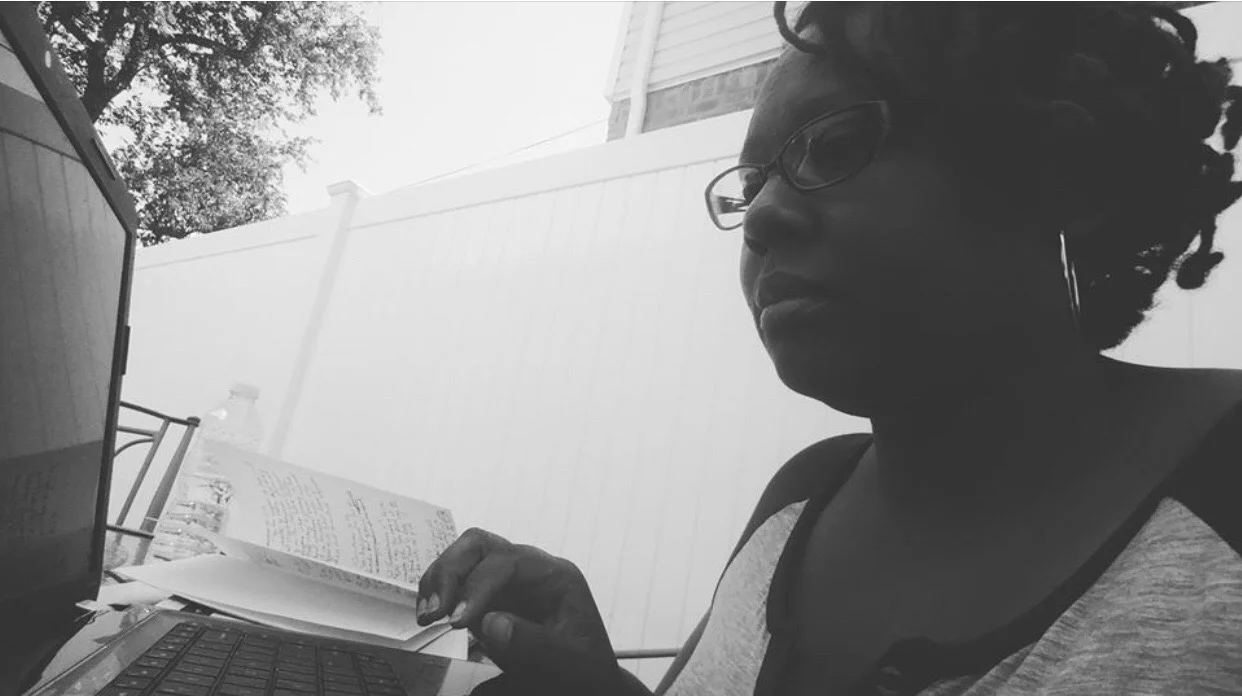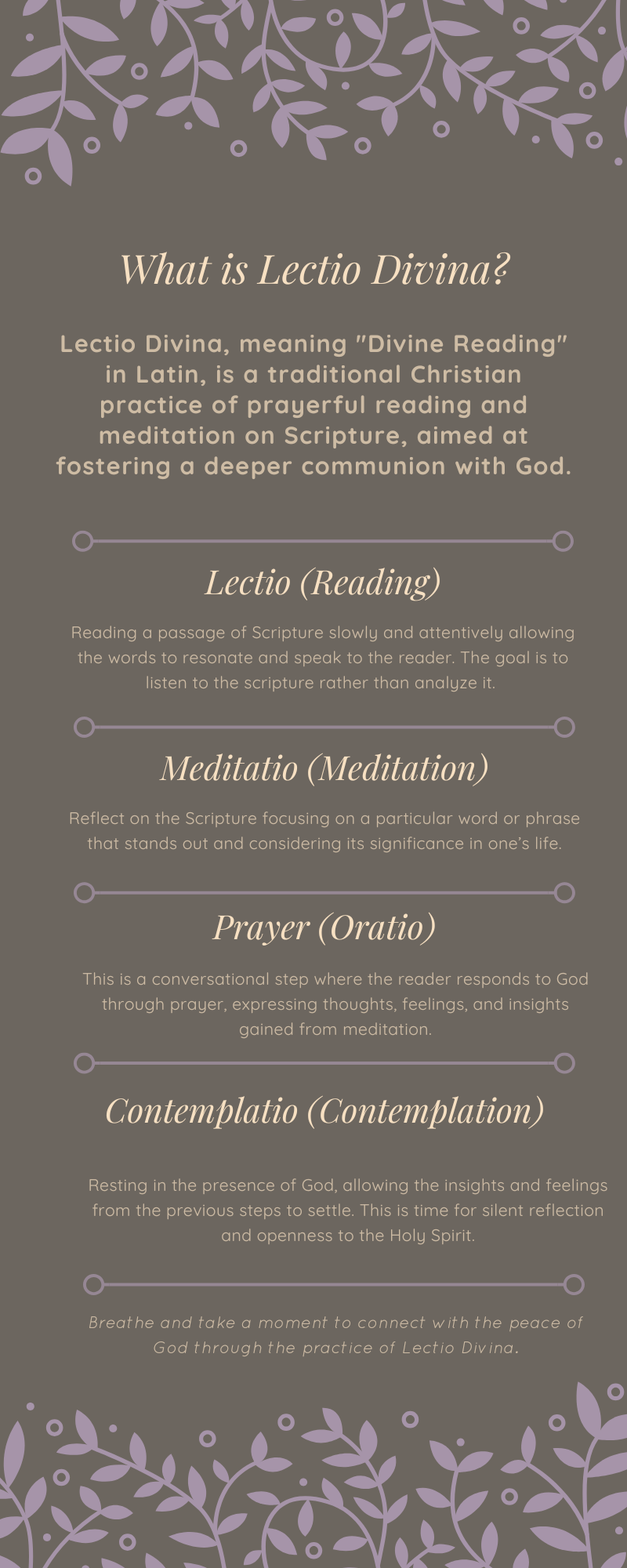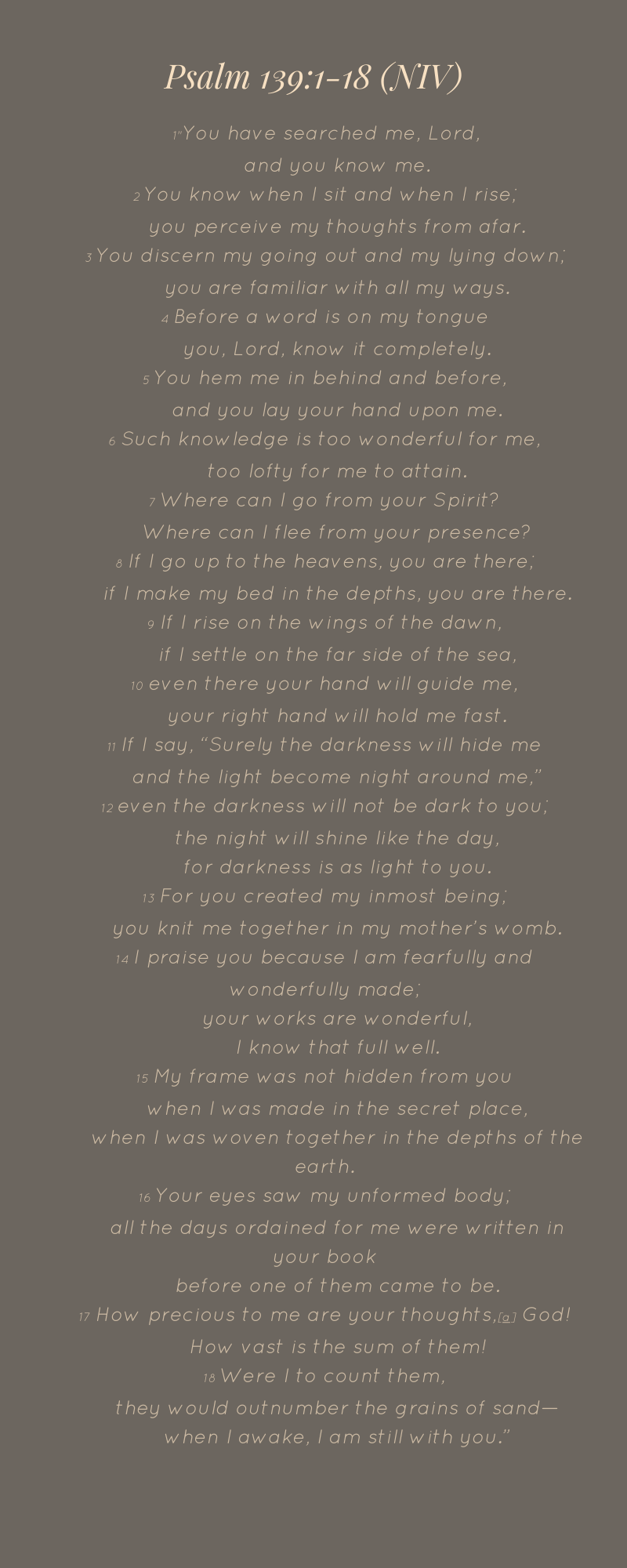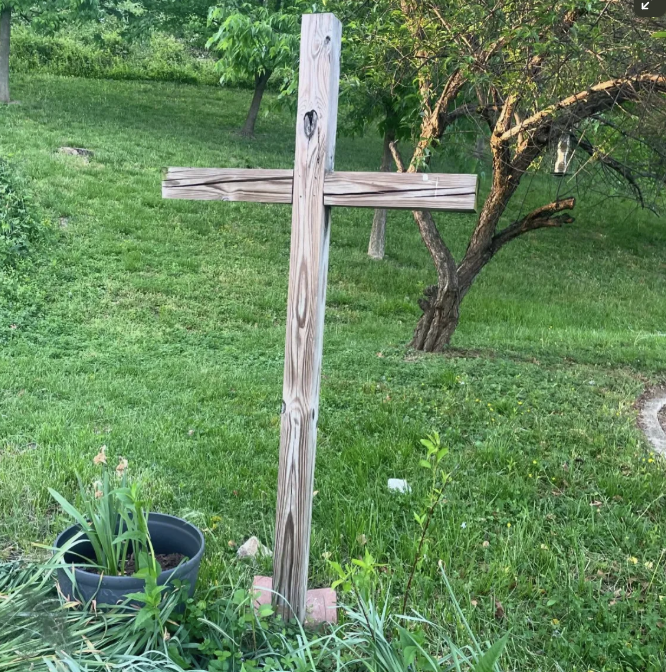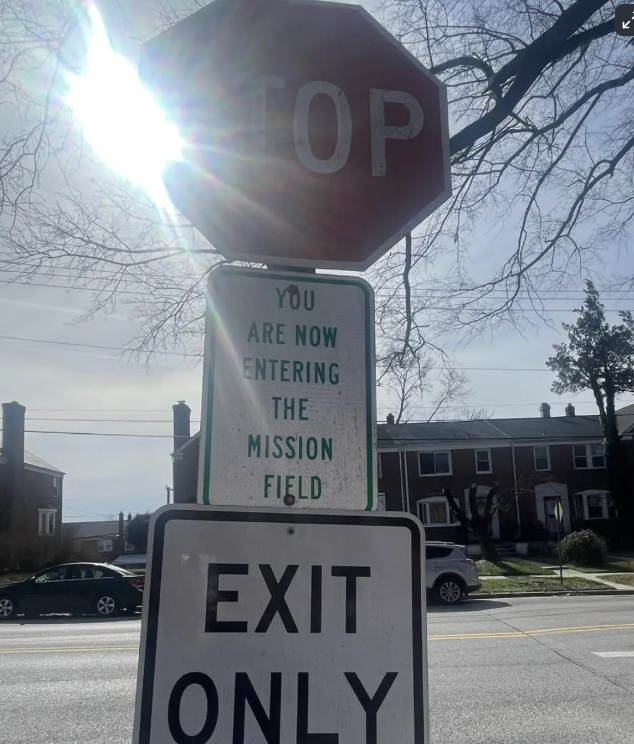Lectio Divina, meaning "Divine Reading" in Latin, is a traditional Christian practice of prayerful reading and meditation on Scripture, aimed at fostering a deeper communion with God.
Come Away with Me
The Holy Spirit often calls me to the Prayer Labyrinth when I’m on my way to run errands. Every time I’m driving in the direction of this sacred place and think God isn’t going to say anything, I feel the Spirit nudging me saying, “Come away with me.”
I turn on my blinker, switch lanes, and make the turn to the prayer labyrinth that sits on the side of the parking lot at St. Matthew Catholic Church. I have walked many labyrinths in the city of Baltimore, but this one is my favorite. Surrounding the labyrinth is a garden that is not too heavily manicured. Honeybees and butterflies are drawn to the wildflowers and hyssop growing there. It’s the garden’s rustic and organic feel that I love.
The labyrinth itself is intimate. The church placed two benches on either side inviting visitors to sit, to meditate, to breathe, to take a break from the heaviness of the world. And, on the other side is a wooden cross reminding visitors that they are not alone, God is there.
Entrance of the Prayer Labyrinth
I discovered prayer labyrinths during a study of Adele Calhoun’s Spiritual Discipline’s Handbook, but I did not think I would find one in the city of Baltimore. My first encounter with a prayer labyrinth was during the pandemic. I, like many, took to walking to help me deal with what was happening in the world and to get a moment to myself that was outside of my home inhabited by my husband and three teenagers.
One day, I happened to stop to tie my shoe and saw, inscribed on a brick, “Enter into these gates with thanksgiving and into this place with praise.”
The invitation
I immediately walked into the entrance of the gates and found a labyrinth that was less than a 10-minute walk from my house.
My first encounter was not the holy experience I thought it would be. In fact, I did not hear the voice of God at all because I was so busy concentrating on following the path to the center and back out again that I missed the point. But God knew I needed the experience of walking the labyrinth first before interacting with me.
The next day, I headed back. This time, I distinctly heard God say, “Come away with me.” I decided to walk looking ahead of myself instead of watching my feet. “Take one step at a time. Trust me.” I sobbed when I got to the center at the thought that God called me. God wanted me. God had invited me to abide.
After that, I was determined to find other labyrinths like the one close to my home. I researched and made a list of fourteen and decided to make pilgrimage to each one. Would the experience be different or the same? What would God say to me? Would the Lord meet me there, too?
Entering the Prayer Labyrinth
Over the course of two months, I visited prayer labyrinths mowed in grass, carved out of stone in courtyards, drawn on concrete in the basement of churches, lovingly crafted outside of hospitals, and one made from brick in the parking lot of a Catholic Church.
The labyrinth at St. Matthew’s quickly became my favorite and it is the one God calls me to most often, probably because this is where God stops me along the way, breaking my routine of moving through life at a nonstop pace. It’s the Holy Spirit’s way of saying, “Slow down, Candance.”
No matter the time of year or the weather, God calls me the same way: “Come away with me to the prayer labyrinth. I am here waiting for you.” Sometimes, there’s natural debris on the labyrinth covering the path. At those times, I became anxious and think, “I can’t see which way to go, Lord!” The Holy Spirit always responds, “Follow me.” I continued walking even though I can’t see the guides along the path. Somehow, I always end up at the center. God says, “I will always lead you to me, even when you can’t see the way. Trust me.”
The Cross
Other times, the way is clear, but I still doubt my steps. The Holy Spirit responds with, “Follow me step-by-step. Don’t worry about what’s coming. Just follow me step-by-step. Don’t look down the road. Just follow me step-by-step. Trust me. Step-by-step.”
One morning, after walking the labyrinth at St. Michael’s Catholic Church, I got in my car to leave when I read the sign that had been bolted above their stop sign that said “STOP you are now entering the Mission Field. Exit only.”
Two thoughts came to mind: First thought: How sobering it is that God entrusts us with the work of the Mission Field, to shine the Lord’s light on the body of Christ whether they know the Lord or not? We are often the only representative of God many will see which is why it’s imperative that we ask the Holy Spirit to operate with the Fruit of the Spirit—love, joy, peace, forbearance, gentleness, kindness, goodness, faithfulness and self-control—at all times. That’s what tending to those in the Mission Field is all about.
You’re entering the Mission Field
Second thought: How fitting is it that the prayer labyrinth is positioned in a space that is tucked away from the street and this sign? The labyrinth is visible yet far enough away to offer a brief respite along the way. Sabbath and time alone with God are so important BEFORE heading out to the Mission Field. It is the space where God speaks, where God hears you, where you can lament, where you receive instruction, where you can exhale what’s bothering you and inhale the peace of God. It’s the space where God prepares you to do the work.
I teared up when I saw that sign. There is so much work to do, especially now, but I am in awe of the fact that God trusts me to do the work. The prayer labyrinth is a roadmap for my life. God is there to help me navigate all the bends and turns that I encounter. That is why I always answer when I hear “Come away with me.” God calls me and I am grateful the Lord chose this special place for us to commune together.
Meeting God Through Centering Prayer
Centering Prayer is a form of contempletative prayer where those in prayer seek to quiet scattered thoughts in the still center of Christ’s presence. Take a moment to learn how to commune with God daily.
Stories from the Camino de Santiago: “I Am With You”
In November, I was intereviewed by Fuller Magazine about my experience walking the Camino de Santiago. The original article was published in Fuller Magazine’s website.
The Camino de Santiago (or the Way of St. James) is a large network of ancient pilgrim routes stretching across Europe and coming together at the tomb of St. James in Santiago de Compostela in northwest Spain. This path has been trodden by pilgrims seeking spiritual formation and life transformation for centuries. The experience of walking this sacred path encourages pilgrims to deepen their faith through inner reflection, silence, holy listening, personal healing, prayerful contemplation, and communion with other pilgrims on the path. This past summer of 2023, a group of Fuller staff, students, and faculty embarked on the pilgrimage, walking over 80 miles of the Portuguese Way, one branch of the Camino. In this series of interviews, students share about their experiences of this spiritual journey.
Candance Greene is in her third year of Fuller’s MDiv program, with a concentration in chaplaincy. She is an ordained minister in the African Methodist Episcopal Church and is the associate pastor of Gethsemane AME Church in Baltimore, Maryland.
Kevin Doi: Candance, thank you for being here. And thank you for walking with us this summer. Let’s dive into the Camino and your experience. Can you share a little bit about what led you to embark on the Camino?
Candance Greene: To be honest, I had never heard of the Camino until I saw the email from the chaplains. I was thinking, is this something the AME or Black people of faith know about? Do we know about the Camino? I didn’t. I read the description and immediately thought, “I’ve got to do this.” There was a burning desire within my heart to do it. When I feel that, I always know the Holy Spirit is leading me in a certain way or guiding me to do something that I’ve never done before. I knew it was going to happen. It’s like the burning bush—those are the times I really know. All I have to do is say yes.
KD: What did you understand about pilgrimage before taking part in this journey? And how did you prepare?
CG: The only thing that I knew about pilgrimage was: nothing.
I started doing my own pilgrimages to local prayer labyrinths. We have 13 here in Baltimore. I needed to hear from God. I didn’t realize it at the time, but that was really the beginning of my Camino. I took time every Friday, from January to early March, visiting these prayer labyrinths and just listening to what God was telling me. As I was walking, I’d say to myself, I’m preparing to hear from God—which I did on the Camino in an extraordinary way. That helped prepare me to walk and be in tune to God. It was just me and God on my pilgrimages to these local prayer labyrinths. That was one thing I did to prepare my spirit.
KD: Where did that come from—to feel drawn to these labyrinths in your city? And at what point did you realize, “Actually, I’m beginning to walk the Camino now”? Can you share about this sense you had of needing to prepare yourself spiritually?
CG: I was not really aware that I had started my Camino process until we got to Spain, and we started talking about when our Camino has begun. I didn’t make that connection beforehand. When I walked the prayer labyrinths, I was in the middle of really deep depression and grief. I lost my dad. One of my good friends was the headmaster of the school in Nashville who was killed by a school shooter. And then my godmother passed away. I had three deaths back-to-back. I just needed to connect with God, like, “What can I do, Lord?”
I’ve always loved walking the prayer labyrinth. There’s one that’s half a mile from my house, so I walk that one all the time. But then I started thinking, there are other labyrinths. What is it like to walk those? Because every prayer labyrinth is different. So I Googled prayer labyrinths in Baltimore, and that’s where I found the list.
Prayer Labyrinth in Baltimore City
At each one, God said something different. So that process helped me to get my spirit in tune to be able to hear God—to feel the presence of God without needing anyone or anything else. The silence is where I met God. It was what I needed because I was in such deep grief and mourning. I was mourning so deeply—I didn’t realize how deeply I was mourning until I got to Spain. But I’ll tell all that later.
KD: Can you share about some ways God met you on the pilgrimage? What invitations did you sense from the Spirit along the way as you were walking on the trip?
CG: The first days were really pivotal for me. The first day was proving to myself that I got this physically. But at some point, the silence was too much—I was too much in my head. So, I had to listen to music, to Tasha Cobbs, and there is a song I just kept listening to. That song sent me into such deep worship, and that is where God established how he was going to communicate with me: through water.
Every time I would see water or hear water, that was my sign that God was with me. “I’m with you, I’m always with you.” So, here I am walking and thinking, “God, you aren’t here for me.” And then I see the water. At one point, we had to walk by a creek and walk over these slippery rocks. It was drizzling, and I did not want to injure myself on day one. God said to me, “Every time you think that your steps aren’t sure, look to the water.” And I look and I see the water. Every time we passed water, even little fountains in people’s yards, God said, “I am here. I am here. I am here.” That was my constant message from God. “I am here. Even in the rain. I am here. I am here. I am here.”
Another thing was walking past all the vineyards. Of course, I’m thinking of John 15; that’s one of my favorite scriptures. I’m thinking, “Wow, you’re pruning me. You’re pruning me.” So, God and I were having some conversations on that first day. The Lord was saying, “Whenever you see water and whenever you see the grapes, I am here with you.”
Day two, I’m thinking it’s going to be this other beautiful day. But that day was the day with the hills. “How do you endure?” That’s what God was asking me. “How do you endure? Are you complaining? Are you looking around, are you seeing?” I was going uphill. I wasn’t looking ahead of me. I wasn’t paying attention to what was around me, and God kept saying, “I need you to look up. I need you to look. Be in this moment, even though it’s hard. Be in this moment, because I’m walking you through it.” The constant water was the rain, and I had to settle my spirit into it.
At some point, there was one last hill. I remember sitting on a rock and that’s when I said, “Why did you bring me here?” I even texted my husband, “Why am I doing this? I can’t do this. I’m done with this.” And then God said, “You’ve got to go the rest of the way. Do it to the end.” It showed me how I deal with adversity and how I deal with hard times. I go through them like this: I don’t look around. I’m riding the roller coaster with my eyes closed. That’s how I’ve been dealing with adversity in my life—“Just let me get through it and then it’s over.” But I don’t learn anything from that because I’m not really trying to figure out whatGod is saying to me in this season or in this hard time. I’m just trying to get past it so it doesn’t hurt anymore. That was when I realized that’s how I was grieving. But God was giving me a new rhythm to learn how to get through the difficult times.
Water along the way.
Day five is when I walked by myself for the first time, and it was probably the best thing I could have done because God really spoke to me. When we were walking, you were supposed to see arrows or shells [marking the way], but I wouldn’t see any markers for a while. “What’s going on?” I’d say. Then I’d hear the water, or I’d see a fountain. And then, look, there’s the arrow. God was saying, “I am with you. You’re not lost. Trust me to lead you and guide you.”
That’s the day that we walked through the canopy of grapes. So, John 15 again. I’m walking, I’m crying. I had a moment where I was raging at God, lamenting. It was extraordinary. I have never felt the presence of God that present or that consistent ever. It was like a cloak. It was beautiful.
KD: That is lovely. The way that you describe each of those days is very powerful. As I’m listening, I’m thinking we must all have a million and one sermon illustrations from the Camino.
CG: I think everybody’s story is going to be totally different. We walked it together but we had different individual experiences along the way.
Another issue I had was my blisters. I had blisters on every toe, and I had to figure out how to redirect my thoughts. It was extremely painful. I thought I had prepared; I had my compression socks, little blister pads, everything. My toes were fully wrapped, but there were times it was excruciatingly painful. I also had a knee issue that started the third or fourth day. So, I had to redirect my thoughts and think differently to get through those days. I had to speak life to myself and speak life to my feet.
That day I walked by myself, I stopped on that long wooded trail that seemed to go on forever. It was like being in the Shire. I took off my shoes and socks, and I sat there for a while thanking God for my feet. “Thank you for my feet, thank you for my toes. I’m still able to walk.” What surprised me was my body—what my body endured—and how much I appreciated my body. I was saying, thank you for my feet. Thank you for what you’ve done, how you’ve carried me through this. Thank you for my ankles that didn’t break down. Thank you for my knee. I was thanking every part of my body because my body could have broken down but it didn’t. It made me appreciate my body and what my body can do.
The wooded walk.
KD: Did that appreciation continue as we arrived in Santiago? How was that for you, when we got there?
CG: I was relieved. I would not have been able to make it another day. But then again, maybe so. Because of the way we walked in, our backs were to the cathedral, but there was something about turning around and seeing the cathedral that felt like, “Oh, my God, we actually made it.”
KD: It was nearing evening, and the cathedral was glowing at that point, right? With the way the setting sun was hitting it?”
CG: It was. And it was that moment of accomplishment. We walked all these miles, and God met us every step of the way. It was beautiful.
KD: You’ve already shared much of this, but are there any other ways the pilgrimage shaped or reshaped you?
CG: I’m still trying to wrap my brain around that. I do know that I left the heaviness of my grief in Spain. And I actually came back with joy, which I had not experienced in years. Since coming back, I’ve been trying to do things that are fun. I’ve been so work-driven and so in my head. There was something about that second day and realizing how I had been walking through life—I feel like the shackles were released. Yeah, life is still hard. There are still difficulties. But I still feel joy, which I hadn’t felt in so long. I’ll always be grateful for the Camino and meeting God there because so much of my pain was released.
To this day, I still feel joy. Part of me thinks, when is the other shoe going to drop? But even if I’m having a bad day, you know what? I still have my joy. I still have peace. I still know that I don’t have to be in Spain to feel the presence of God. But God took me out of here to reorder some things. And I returned with joy.
KD: Like it was restored to you.
CG: I had been praying for so long, “God, I just want to feel joy, and I want to be happy.” Because I couldn’t even answer the question, when was the last time you felt joy? Helping people, standing in front of the congregation, doing sermons, praying for people, doing everything in between—I was dead inside. God restored my joy in Spain, and I’m so grateful.
KD: Can you share about the joy that you feel? What does it feel like for you?
CG: Remember when I talked about the burning bush and the call? It’s still lit, but it’s all over. I think something had to be ignited, so that was the call to go on the Camino. But now, it’s constantly burning, and it’s a calm feeling. I felt empty before, and I couldn’t figure out why. But now I know. And now, it’s like a burning light. It’s not painful. It’s comforting. That’s what the Camino did for me.
Kevin Doi is a Fuller Seminary chaplain.
Candance Greene is a Fuller MDiv student, with a concentration in chaplaincy.
Originally published
November 8, 2023
Journey Along the Camino de Santiago: Learning a New Way Along “The Way”
Standing in front of the Cathedral de Compostela
L to R: Me, Keisha and Dr. Tina
“Pilgrimage invites us to allow all of life to become an intentional journey, even in the midst of
loss and grief. It is a call to find God in new ways.”-Christine Val Leis Painter
217,287. These are the number of steps that chronicle my eight-day journey walking the Camino de Santiago this past August. I had never heard of the Camino until it was presented to me by the chaplains at Fuller Theological Seminary where I am in my third year in the MDiv program. In fact, the only pilgrimages of which I was aware were to Jerusalem and Mecca.
The chaplains explained that the Camino is a holy pilgrimage that stretches across Europe to the tomb of St. James, the disciple, in Santiago de Compostela. Our goal was to walk the Portuguese branch of the Camino from Tui in Portugal into Spain via Porrino, Arcade, Pontevedra, Caldas de Reis, Padron and Santiago. Our purpose would be to take in the experience of walking this sacred path as pilgrims—the term used to describe those who walk the Camino—to deepen our faith through inner reflection, silence, holy listening, personal healing, prayerful contemplation, and communion with God. I knew immediately that the Holy Spirit had extended an invitation and that the Lord was calling me to the Camino.
In early August, armed with hiking poles, two pair of hiking boots, tons of compression socks, weather-appropriate clothing, a wide variety of foot blister pads and my Bible, I boarded a flight from JFK to Tui (with a quick stop in Madrid and Marrakech).
Walking “The Way”
I began my daily treks with my Fuller cohort, but soon our individual paces resulted in the parting of ways. This made the Camino a solitary journey. The only guide I had was either a yellow and blue arrow or seashell imprinted on stone monuments or spraypainted on the ground every two to three miles that pointed “the way” I was to walk.
Wearing two different pair of shoes to help with the blisters.
The Camino was not for the faint of heart. On average, we walked 12-15 miles each day along highways, on wooded trails, in communities, past farmland and through acres of vineyards. Sometimes I encountered pilgrims from other parts of the world, however, most of the time, I walked alone for hours. I traveled north, which meant the majority of the pilgrimage was uphill, steep inclines that sometimes took my breath away.
The Holy Spirit established our mode of communication on the first day. God revealed his presence every time I heard or saw water. I am with you. You are not alone. Don’t be afraid. Breathe, Candance. In the rain, God was with me. During the heat of day, God was with me. When I felt lost, God was with me. All I had to do was be in the moment to hear God say, I am here. I am here. You are not alone.
Water connecting me with the Holy Spirit
I traveled to Spain wearing a cloak of grief. In the early part of the year, my father died and another friend was murdered in the school shooting in my hometown of Nashville. I wore the mask and told everyone I was well, when, in all actuality, I was falling apart on the inside. That was until God called me to pilgrimage in Spain. I saw the Lord in everything—along cobblestone roads, walking past canopies of grapes, stopping to take pictures of lemon and lime trees, listening for the sounds of water. God’s presence was tangible. He reveled himself to me. He walked with me. He talked with me. He guided me. He admonished me. He encouraged me. He let me vent and cry out in rage. He poured into me. He made me stop by the still waters and replenished me. He took my cloak of grief and replaced it with joy.
The morning of my solo trek
On Sunday, August 6, 2023, after a 94-mile sojourn over eight days, I stood in front of the Cathedral de Santiago de Compostela with tears streaming down my cheeks. I had blisters on every toe, braces wrapped around both knees, was slightly sunburned and a little dehydrated, but none of that mattered. What I gained was a personal understanding of Isaiah 43:18 “Forget the former things; do not dwell on the past. See, I am doing a new thing! Now it springs up; do you not perceive it?” The Lord did a “new thing” within me when he unlocked joy that I had not experienced in years. For those eight days, the Camino was the real world. Everything I experienced—the exhaustion and the exhilaration, the arduous journey and the euphoria, the pain and the pleasure—happened. It was real and God was with me orchestrating the most beautiful experience of my life.
Lent 2024: The Importance of Abiding
Abiding is really relationship-building. God wants a relationship with you, one that is both give and take, one where you speak, but where you also listen. During the season of Lent, you develop a close relationship with God so that the communication flows between the two of you. This type of communication only comes through the act of abiding in him.
Lent 2024: A Deep Well of Faith
Isn’t it interesting how often we fall back on fear? Speaking for myself, falling into fear is easier because it happens without a fight. All I have to do is allow the enemy to fill my head with negative thoughts, worst case scenarios and the myriad of ways everything can go wrong so I can allow myself to be sent spiraling into an abyss of negativity. But it does not have to be this way.

